Anyway one of our first stops was Elko Nevada, known for its Basque restaurants and not much else. I'm not going to name the restaurant we chose, because short of that really bad Ethiopian place in San Jose it was quite possibly the. worst. food. ever. I remember walking into the place and seeing this guy sitting there surrounded by enormous plates of food, and thinking to myself "Oh, look, a food critic." Well guess what, he was just a guy who placed one regular order. Because everyone who eats at that place gets surrounded by enormous plates of completely inedible food. I guess huge portions is their chef's way of compensating for the total lack of quality.
Amongst those culinary treasures placed before me was a heaping plate of spaghetti,which I really just can't imagine hailed from the Basque region of France/Spain. Anyway you know that canned spaghetti you used to eat as a kid (or maybe you had better tastes than that, even then)? I'm pretty sure this was canned spaghetti. Mushy, totally overcooked noodles and Ragu sauce. There was also a plate of vegetables that was just like Mom used to make (she boiled the hell out of those veggies until they became a pile of nondescript gray fibers). Canned baked beans. Generic French fries and a mediocre steak.
So that was my one and only experience with Basque food, up until this entry. Though even then I was not dumb enough to think that that experience might be similar to what I would get if I was in, you know, the actual Basque Country.
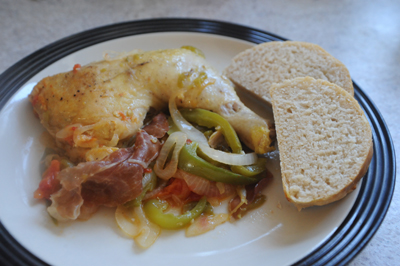 |
| This is not the meal we had in Elko. It's much too small. And it didn't come out of a can. |
 |
| This map just shows the Basque Country, where our menu is from. |
One of the coolest things about the Basque Country is its language, called "Euskara." What makes this language so interesting is that it is isolated, and not really similar to any other known language—not even French or Spanish, though the Basque Country is located in both nations. There are some very minor similarities to the Georgian language, which suggests that the original inhabitants of this region may have migrated from the Caucasus Mountains, but no one really knows for sure.
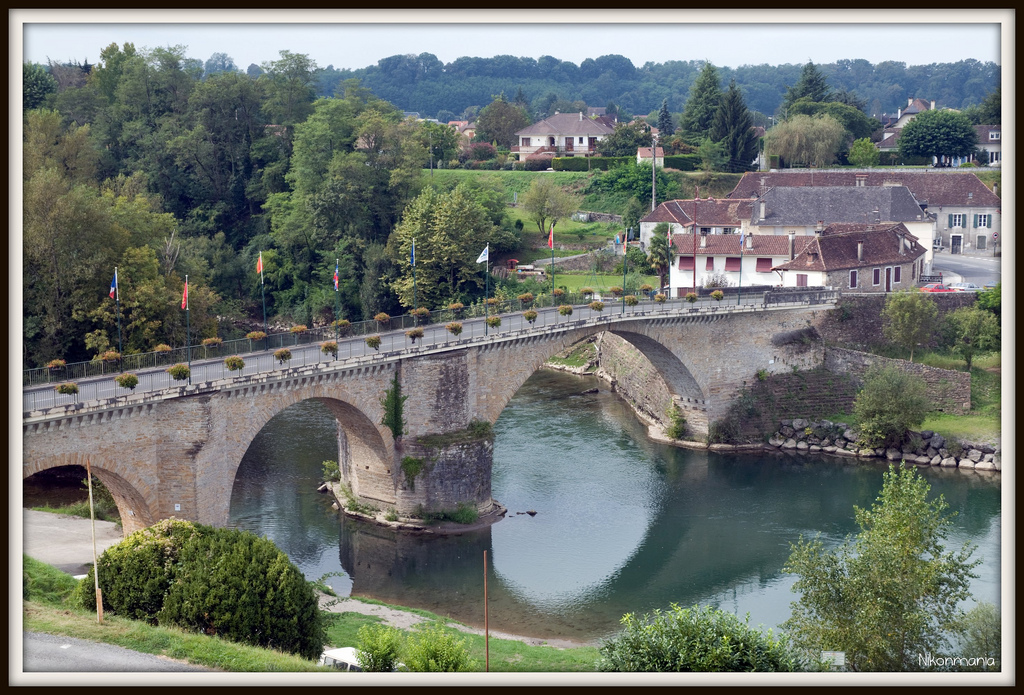 |
| Navarrenx, Basque Country, France. Photo Credit: Nikonmania. |
Basque Chicken
(from Cuisine-France)
- One 4 lb chicken
- 6 oz Bayonne ham (prosciutto is an acceptable substitute)
- 1/2 cup olive oil
- 3 or 4 tomatoes, crushed
- 5 green bell peppers
- 4 cloves garlic
- 2 onions
- Salt and pepper
(from The Guardian)
- 1 1/3 cup lukewarm water
- 1/4 tsp instant dry yeast
- 4 cups all-flour, plus extra for shaping
- 1/2 cup spelt flour
- 2 tsp fine salt
(from Easy French Food)
- 2 cups all purpose flour
- 1 cup unsalted butter, cut into small pieces (50 or so)
- 1 cup sugar
- 1 egg
- 3 egg yolks
- 1 teaspoon vanilla
- 1 teaspoon baking powder
- 1/2 teaspoon salt
- 1 12-oz jar black cherry preserves
*
So we have to start with the bread (yes I know it's soup bread, and I didn't make any soup, but it looked yummy in the photos), because it's one of those "do the day before" recipes. Can you guess whether or not I did it the day before? Nope! So I don't think I can really say I've made zopako, because I'm pretty sure the recipe actually depends on this step. Maybe I'll make it again and serve it with the Chicken Yassa from last week,which I also got wrong.
So here's the proper way to do it: mix the water with the yeast (yes, it's a very small amount of yeast, but it is the correct amount), then add the all-purpose flour, the spelt flour and the salt. Knead until you get a firm dough, then put in a bowl and cover with plastic wrap. Leave at room temperature for 12 hours.
Now, if I had to guess (and that's exactly what I'm doing, guessing) I would say that sitting out overnight helps give the bread a slightly sour flavor. That is also the purpose of the very small amount of yeast—it keeps the dough from getting over-inflated after sitting out for so long. Now, because I didn't let my dough sit out overnight I used more yeast (about two teaspoons). But that's not the right way to do it.
Now once the dough has risen, shape it into a long loaf and place it on a baking sheet lined with wax paper. Cover and let stand for 30 minutes, then dust with flour and use a rolling pin to press down hard in the center. You'll end up with two loaves joined by a thin bit in the middle.
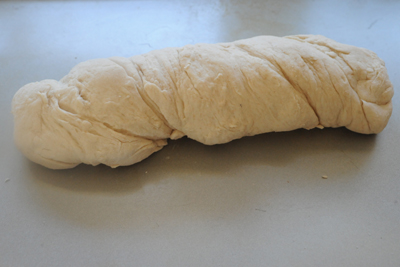 |
| I halved my recipe, so I only made one loaf. |
Let rise for 30 minutes more, then put a small oven-safe dish full of water on the bottom shelf of your oven. Now put the bread in and bake at 465 degrees for 20 minutes. Reduce the heat to 390 degrees and continue to bake for 15 to 25 minutes, or until you get a nice golden color (I used an egg wash on mine, again not in the directions but I figured I was already screwing it up anyway).
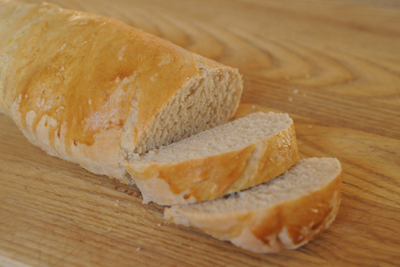 |
Mix the flour with the butter, sugar, egg, two of the egg yolks, vanilla, baking powder and salt (it's easiest if you use your fingers). Keep mixing until you get a dough.
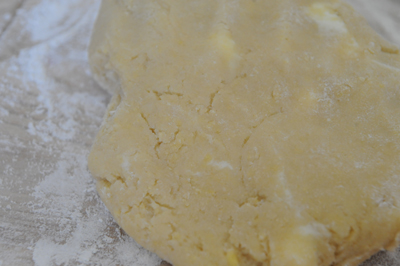 |
Wrap the dough balls up in plastic wrap and chill in the refrigerator for at least 30 minutes.
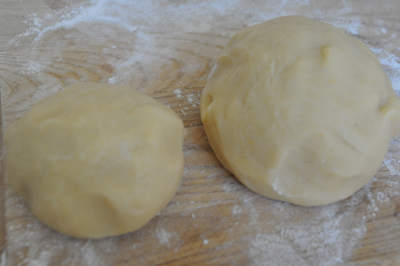 |
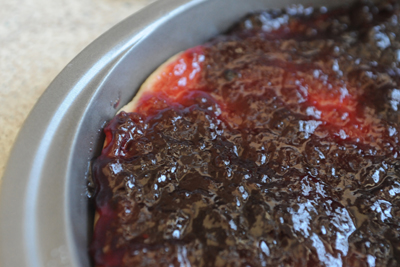 |
| Why does this photo look like it belongs in the opening credits of Dexter? |
Put the smaller dough ball on a floured surface and roll it into a pan-sized circle. This gets a little tricky because this dough tends to fall apart when you try to lift it. I ended up putting mine into the pan in pieces, but it smoothed out when I brushed on the egg wash, which is the next step (mix the remaining egg yolk with 1 tbsp water and brush over the dough).
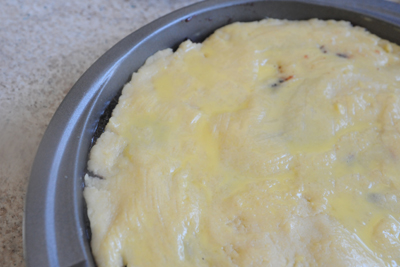 |
Now here it says to let sit for one day before eating. Oh, please. You will not be able to let this cake sit for one day.
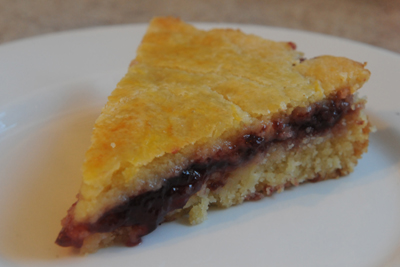 |
Cut up the chicken and season with salt and pepper. Put half of the olive oil in a large pot over high heat. Brown the chicken on all sides, then cover and cook over medium for 15 minutes.
Peel and seed the bell peppers. Peel them?? Seriously? If you've ever tried to peel a bell pepper that hasn't been roasted first, you will end up without very much pepper left over. I didn't peel mine. I suppose you could try blanching them like a tomato to see if that helps, but honestly I have never heard of peeling a bell pepper that you're just going to cook in a pot, so I didn't bother.
Cut the peppers into large strips and put in the pot with the chicken. Add the prosciutto and garlic. Cook for an additional 20 minutes.
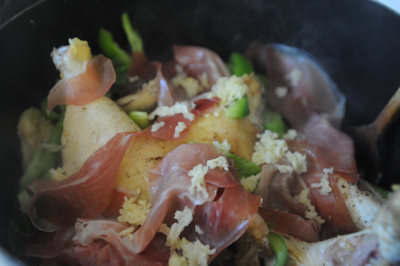 |
 |
The chicken was a little bland, I thought. But based on the ingredients I really wasn't terribly surprised by that. The bread was also a little bland, because I forgot to put salt in it. Sigh.
But the cake … I never use the term "OMG" (except for that other time), but OMG. This cake was mind-blowingly yummy. This cake is something I would ask for on my birthday. It was so delicious that I almost gave it away for fear that I couldn't be left alone with it. Fortunately my kids devoured all the leftovers. Oh my god, it was tasty. In fact this might even be my favorite Travel by Stove recipe so far this year. If you only make one thing from the Basque Country, make this cake. Seriously.
Now one more thing, loyal readers (all 10 or so of you), we have a visitor from England here for the next couple of weeks. So although I will still be cooking I don't know how much I will be able to post, because we have over-scheduled the hell out of our poor visitor.
Anyway I may post next week, but maybe not. If not, I'll see you when I come up for air.
Next time: The Gaza Strip.
For printable versions of this week's recipes:











0 comments:
Post a Comment